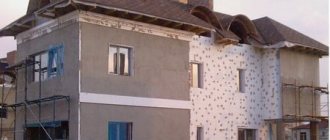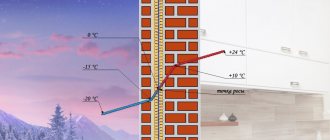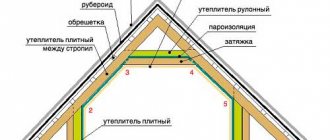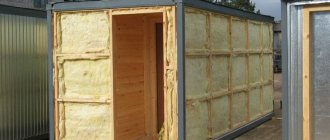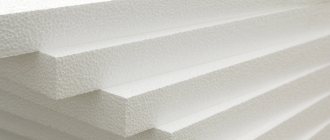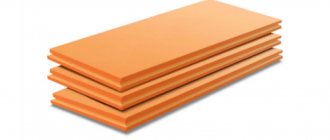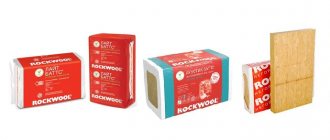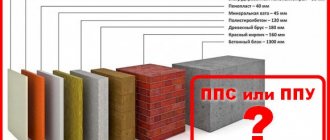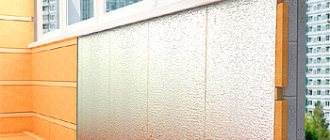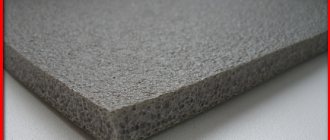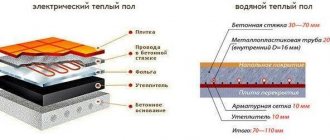What is mineral wool
This is a thermal insulation material, the production process of which is based on the processing of stone rocks. From the latter, threads are obtained, which are mixed in a chaotic manner. This is how the strength of mineral wool is achieved. And the spaces between the threads are filled with air. However, they are not closed, that is, air moves freely inside the material.
On the one hand, this is good, because the air space provides high thermal performance. But on the other hand, this is bad, because the air can easily be displaced, for example, by moisture in the form of condensation and water. And this is a decrease in thermal characteristics.
Regarding the density of stone wool. Firstly, density is the number of stone fibers found in 1 m³ of material. That is, the more threads, the higher the density. Accordingly, there is less free space between the fibers. This means that the thermal conductivity of the material increases. By the way, for mineral wool it varies in the range from 0.032 to 0.046 W/m K. It is this range of indicators that depends on the density of the material.
Structure of mineral wool Source kursremonta.ru
The classification of mineral wool is precisely determined by the density of the products offered. Today, manufacturers offer four classes of mineral wool slabs:
- P-75 with a density of 75 kg/m³. This variety cannot be used in loaded structures because it has the lowest strength. A good option for insulating roofs and walls.
- P-125 . These are more rigid slabs, but not so much that they can be laid under screeds. Therefore, the main purpose is roofing structures, walls and frame structures.
- P-175 . A rigid slab that can withstand quite heavy loads. Such slabs are laid during the process of insulating concrete floors, that is, under screeds.
- PPZh-200 . These are so-called mineral wool slabs of increased rigidity. They are used mainly for insulating concrete coatings, floors, and in structures that have high strength characteristics and fire safety requirements.
Mineral wool slabs brand PPZh-200 Source m.2gis.kz
See also: Catalog of companies that specialize in roofing materials.
Please note that the density of mineral wool for roofing has certain parameters. That is, you should not buy products, in this case we mean slabs whose density is higher than 125 kg/m³. There is no doubt that they will do an excellent job on roofs with the functions assigned to them. But they cost an order of magnitude more. Why overpay if there is material much cheaper. But if the task is to insulate a flat roof, and especially a used one, then you can’t do without the P-175 brand.
Let us add that initially mineral wool was produced in rolls and mats. And today both options are present on the market. They are used less frequently, but they are represented by a wider range of models, where the density of products varies over a wider range: from 40 kg/m³. It should be noted that underestimating the density makes it possible to use rolled material and mats in the process of insulating roofing structures. The only thing is the difficulty of laying insulation on pitched structures. It is necessary to use temporary fastening methods, which complicates the process itself and increases labor costs.
Roll type mineral wool Source domaleto.ru
Using mineral wool with different densities
Let's look at the density of mineral wool using a few examples. That is, we will designate for which structures, what class of insulation should be used.
For facade
Wall insulation with mineral wool is carried out in two ways:
- Under plaster . Here the insulation is installed, a reinforcing frame is laid on it, on which the plaster solution is applied. It turns out that the heat-insulating layer bears the weight of the plaster layer. And this is sometimes quite a significant load. Therefore, in this case it is recommended to use mineral wool with a density of 100 kg/m³.
- Ventilated facade . This is a frame structure made of wooden beams or metal profiles, which is attached to the wall of the house. Thermal insulation material is laid between the sheathing elements. It turns out that the latter does not bear any load. This means that material with a density of up to 100 kg/m³ can be used here.
Mineral wool inside a ventilated facade Source tn.ru
Insulation of walls from the inside
Here, in principle, the same option as for facade planes. Only instead of a ventilated facade, they use a sheathing that is attached to the wall. For this type of insulation, it is better to use mineral wool in rolls or mats with a density of 40-60 kg/m³.
What affects the density of insulation?
The stationary air between the fibers of basalt insulation provides a low thermal conductivity coefficient, which guarantees the required level of thermal protection. When insulating various structural elements, sometimes it becomes necessary to neglect this ability of air to create a reliable thermal insulation layer. When working with loaded surfaces, such as floors and roofs, it is necessary to use a material that can withstand the load without “compressing”, thereby losing many of its advantages.
Video description
The video shows the technology of insulating a roof structure with mineral wool:
Insulating the attic with basalt wool Source es.decorexpro.com
Floor insulation
Here, the density of the insulation is selected depending on the method of forming the floor base.
- By lags . That is, mineral wool is not subject to loads, because it is located between the lags. The latter bear the entire load from the floor covering. Therefore, the density of the thermal insulation material should not exceed 100 kg/m³.
- Under a concrete screed . Here, as mentioned above. The minimum density should not be less than 175 kg/m³.
Video about an energy efficient house
Mineral wool is used as a thermal insulation layer by both professional builders and individuals when constructing their own houses. It is a material made from fibers of metal slag and molten rocks.
Its distinctive features are good heat-saving characteristics, easy and quick installation, versatility of use, and fire safety. It is for these qualities that builders love mineral wool so much. To choose the type of mineral wool suitable for insulation, you should determine its density.
Generalization on mineral wool
Since the main topic of the article is the density of roof insulation, it is necessary to indicate that the choice will depend on which roof will have to be insulated. If this is a pitched structure, then there is no point in using material with a density higher than 125 kg/m³. If the roof is flat, and even more so if it is planned to organize, for example, a recreation area on it, then mineral wool slabs should not have a density lower than 175 kg/m³.
Insulation of a flat roof with mineral wool slabs Source goldkryshi.ru
What is the best way to insulate a roof?
A comparative analysis of roof insulation and a study of the structural features of the roof will help answer this question. Criteria that a heat insulator must meet:
- low thermal conductivity;
- density;
- shape stability;
- appropriate thickness;
- low ability to transmit moisture;
- ease;
- durability;
- resistance to sudden temperature changes;
- fire resistance;
- resistance to rodents;
- environmental Safety.
By comparing the characteristics of materials, you can easily determine which insulation is the most suitable for the roof of your house.
The thickness of the insulation must be selected based on the climate in the region. Typically, the thickness of the insulation on the roof varies from 50 to 150mm. For a more accurate calculation in these cases, a specialist is invited to avoid unnecessary errors.
Video to watch which roof insulation to choose:
Polyurethane foam for roof insulation
I would like to dwell on one more insulation material, which today is often used for thermal insulation of roofing structures. It is applied by spraying in the form of foam, which polymerizes into a durable mass under the influence of air. A seamless surface is formed on the surface of the processed parts and assemblies, one hundred percent sealed.
It should be noted that the density of polyurethane foam varies over a very wide range: 8-100 kg/m³. So which one is intended for which building structures?
- From 8 to 20 kg/m³ - this is the material that is used for internal insulation and sound insulation. This is an open-cell mass with low mechanical protection that absorbs moisture well.
- 20-25 kg/m³ . Here the situation is this: 50% of the cells are closed, 50% are open. This type of polyurethane foam is used for both external and internal insulation. A mandatory requirement is protection from precipitation.
- Density from 30 to 35 . All pores are closed, which reduces water absorption to a minimum. But such material does not tolerate mechanical loads. Although it is recommended to use it for thermal insulation of foundations for backfilling with soil.
Insulation of the foundation with polyurethane foam Source ppu-perm-master.ru
- 40-45. A material of this density can be used to insulate deep foundation structures.
- 60-70 kg/m³ . Polyurethane foam of this density can be laid under screeds. That is, the density of the material allows it to withstand significant loads. If we talk about the insulation of flat roofs, especially those in use, then this option can be considered ideal.
- 100-110 kg per 1 m³ . This is the most optimal option when the task is to insulate building structures subject to significant mechanical loads.
So, let’s summarize and decide which of the above options is suitable for insulating roof structures. Optimally, it is polyurethane foam with a density of 40 to 60 kg/m³.
Types of insulation for roofs
The manufacturer has taken care of the variety of its own products. The types of insulation are now varied. The roof is insulated with one or more materials.
Thermal insulation properties of various insulation materials.
- Styrene materials. These include polystyrene foam, polystyrene foam, and polyurethane foam. Installation of the roof with them is very easy due to the low weight of the insulation. In addition, the material is immediately cut into convenient pieces, which are intended for roof sheathing sectors. In addition to ease of installation, the advantages of styrene include durability, resistance to moisture and steam.
- Cotton wool. Mineral or glass option. The most popular and cheapest insulation. Has fire-fighting properties. But that's where its positive qualities end. Cotton wool fibers cake at the slightest contact with moisture, and this reduces efforts to insulate the house to nothing. If you open the sheathing after some time, you will see that not a trace remains of the lush density of the insulation. And fiberglass can have a negative impact on health - mineral wool particles are very volatile and will settle anywhere.
- Environmentally friendly types of insulation. It can be slag, sawdust, expanded clay, sand. In a word, such materials are for adherents of natural purity of construction. These types are suitable for flat roofs. And only with installation from above. The thickness of the backfill is determined by the sectors of the sheathing. You just need to take into account that the bottoms of the sectors must be firmly knocked down so that bulk materials do not spill out. The insulation may not be very good, because such insulation absorbs moisture, so they are not afraid of small leaks or condensation, but they should still be avoided.
- Recently, liquid insulation based on polyurethane has been conquering the market. Its advantage is that it contains all the above-mentioned qualities of other materials + the ability to “lay” it without joints and gaps, therefore, either the consumption of additional materials for roof insulation will decrease, or the need for them will disappear completely. In terms of density, it is not inferior to well-known insulation materials.
- Cellulose material can be considered a newcomer to the roof insulation market. Its density is quite good. However, it is not popular due to its seemingly natural ability to ignite, because it is made from waste paper. However, this is not true - fire retardant additives will not give power to fire. But here lies the pitfall - chemistry, and quite volatile one at that. Therefore, the roof selected for covering with such material must belong to a non-residential premises.
Return to contents

